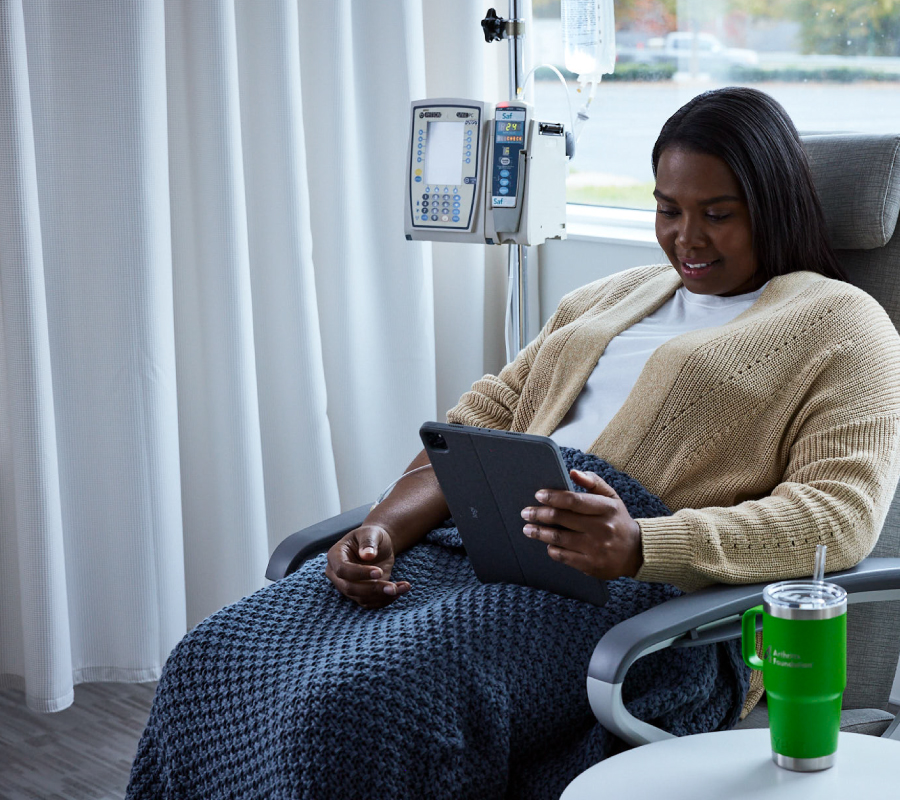From Ice Rinks to Runways
How figure skater and fashion designer Michael Kuluva turned pain into purpose.
By Ann Lindemann | May 7, 2025
From a very early age, 42-year-old fashion designer Michael Kuluva knew he didn’t want to live life on the sidelines. Still, he couldn’t predict the twists and turns his life journey would take after he was diagnosed with rheumatoid arthritis (RA) at age 25.
Today, he’s excited about getting involved with the Arthritis Foundation and supporting the organization’s mission to help people with arthritis improve their quality of life. It’s also a way for him to share his story of living well with arthritis himself to help encourage others in their journey.
 Michael launched his 20-year figure skating career at just 6 years old. He was on the U.S. Figure Skating Team from 1989 to 2001, competing in the 1998 Junior Olympics. After high school, Michael was eager to explore the world, so he pivoted to professional figure skating, touring with Disney on Ice and Holiday on Ice.
Michael launched his 20-year figure skating career at just 6 years old. He was on the U.S. Figure Skating Team from 1989 to 2001, competing in the 1998 Junior Olympics. After high school, Michael was eager to explore the world, so he pivoted to professional figure skating, touring with Disney on Ice and Holiday on Ice.
“It was such an amazing experience,” Michael recalls. “However, it did take a toll on my body after all those years.” So, after two decades of physically demanding competition and performances, he listened to his body’s clear message to lay off body-pounding jumps, spins and spirals.
Undeterred by new challenges, Michael pursued his love of fashion design. “I was always involved with my costume designs, starting as a kid to when I was competing and went pro,” he explains.
In 2008, Michael enrolled in the fashion design program at the Fashion Institute of Design and Merchandising in Los Angeles. While still a student, he launched a fashion line, Tumblr and Tipsy. At age 25, his fashion career was well on track until it took a painful detour.
Navigating a “Shocking” Diagnosis
“I was walking to class, and I had a horrible stabbing pain in my back,” Michael recalls. “I thought it might be a kidney stone or something along those lines.”
After a thorough exam, Michael’s urologist suggested a rheumatologist, who diagnosed him with rheumatoid arthritis. “They performed tests, and my body lit up like a Christmas tree,” Michael says. “It was very shocking. I was not expecting that type of diagnosis.” Michael got second and third opinions and went to the Mayo Clinic for a program that helped him navigate the realities of life with RA.
It was a long diagnostic journey with a slew of harsh side effects, such as fatigue and nausea. “It wasn’t a very good time in my life, mentally and physically,” he remembers. “I had to embrace and fail a lot of different biologic drugs, and it was quite painful.”
Meanwhile, Michael persisted in his creative journey, juggling stressful college demands while his edgy, inclusive designs hit the runway. “I showed at LA Fashion Week, and then I was invited to New York Fashion Week, which was big,” Michael says. “It got an amazing response and my fashion career took off.”
But Michael was hesitant about sharing his diagnosis, as he worried it would cost him sponsorships and/or negative media attention. “We kept it under wraps until I was able to establish myself a bit more; do some television shows like ‘America’s Next Top Model’ and ‘Growing Up Supermodel,’” he says.
By 2016, when Michael was ready to start sharing his story, he knew it had to be positive. “I wanted to communicate that ‘I can still do everything I want to do and complete my dreams. However, I do have a chronic disease, and I’m pushing through it.’”
Throughout it all, the Arthritis Foundation has remained a trusted ally in Michael’s RA journey. “I always admired how the Foundation had so much information available to patients, which I have used in my research to figure out what’s going on with myself.”
He adds that his physicians often recommend the Arthritis Foundation website and newsletters as reliable resources.
From a very early age, 42-year-old fashion designer Michael Kuluva knew he didn’t want to live life on the sidelines. Still, he couldn’t predict the twists and turns his life journey would take after he was diagnosed with rheumatoid arthritis (RA) at age 25.
Today, he’s excited about getting involved with the Arthritis Foundation and supporting the organization’s mission to help people with arthritis improve their quality of life. It’s also a way for him to share his story of living well with arthritis himself to help encourage others in their journey.
 Michael launched his 20-year figure skating career at just 6 years old. He was on the U.S. Figure Skating Team from 1989 to 2001, competing in the 1998 Junior Olympics. After high school, Michael was eager to explore the world, so he pivoted to professional figure skating, touring with Disney on Ice and Holiday on Ice.
Michael launched his 20-year figure skating career at just 6 years old. He was on the U.S. Figure Skating Team from 1989 to 2001, competing in the 1998 Junior Olympics. After high school, Michael was eager to explore the world, so he pivoted to professional figure skating, touring with Disney on Ice and Holiday on Ice.“It was such an amazing experience,” Michael recalls. “However, it did take a toll on my body after all those years.” So, after two decades of physically demanding competition and performances, he listened to his body’s clear message to lay off body-pounding jumps, spins and spirals.
Undeterred by new challenges, Michael pursued his love of fashion design. “I was always involved with my costume designs, starting as a kid to when I was competing and went pro,” he explains.
In 2008, Michael enrolled in the fashion design program at the Fashion Institute of Design and Merchandising in Los Angeles. While still a student, he launched a fashion line, Tumblr and Tipsy. At age 25, his fashion career was well on track until it took a painful detour.
Navigating a “Shocking” Diagnosis
“I was walking to class, and I had a horrible stabbing pain in my back,” Michael recalls. “I thought it might be a kidney stone or something along those lines.”
After a thorough exam, Michael’s urologist suggested a rheumatologist, who diagnosed him with rheumatoid arthritis. “They performed tests, and my body lit up like a Christmas tree,” Michael says. “It was very shocking. I was not expecting that type of diagnosis.” Michael got second and third opinions and went to the Mayo Clinic for a program that helped him navigate the realities of life with RA.
It was a long diagnostic journey with a slew of harsh side effects, such as fatigue and nausea. “It wasn’t a very good time in my life, mentally and physically,” he remembers. “I had to embrace and fail a lot of different biologic drugs, and it was quite painful.”
Meanwhile, Michael persisted in his creative journey, juggling stressful college demands while his edgy, inclusive designs hit the runway. “I showed at LA Fashion Week, and then I was invited to New York Fashion Week, which was big,” Michael says. “It got an amazing response and my fashion career took off.”
But Michael was hesitant about sharing his diagnosis, as he worried it would cost him sponsorships and/or negative media attention. “We kept it under wraps until I was able to establish myself a bit more; do some television shows like ‘America’s Next Top Model’ and ‘Growing Up Supermodel,’” he says.
By 2016, when Michael was ready to start sharing his story, he knew it had to be positive. “I wanted to communicate that ‘I can still do everything I want to do and complete my dreams. However, I do have a chronic disease, and I’m pushing through it.’”
Throughout it all, the Arthritis Foundation has remained a trusted ally in Michael’s RA journey. “I always admired how the Foundation had so much information available to patients, which I have used in my research to figure out what’s going on with myself.”
He adds that his physicians often recommend the Arthritis Foundation website and newsletters as reliable resources.

Help Is A Phone Call Away.
Got questions about arthritis? Our Helpline is here for you, with resources and information when you need it.
 High Fashion Inclusivity & Diversity
High Fashion Inclusivity & Diversity Michael, a member of the LGBTQ+ community, embraces diversity and inclusivity in his design ethos. “I like to have everyone included, as many people as possible; all different ages, sizes, genders, everything,” he explains.
To that point, inclusivity of the arthritis community is widely represented in his work. For instance, he’s created apparel designs featuring light-up starbursts on joints where pain is centered. “Having an invisible disease, people sometimes still don’t understand it. That was a big stride, especially in the arthritis community.”
His collections often feature fashionable magnetic closures and large zippers, which make it easier for people with less strength to get in and out of clothing. Unlike clunky Velcro closures, Michael’s designs are firmly planted in the high fashion camp.
“I work with a lot of people in wheelchairs on and off the runway,” he says. “I’m able to bring new ideas and concepts that are accessible for people with all mobility issues.”
Designed for Success
In a hands-on business, Michael can’t always rely on his hands. He finds creative workarounds, employing assistants to help with fabric cutting, illustrating and daily emails. And it’s all-hands-on-deck when Michael’s preparing for a runway show.
He follows a strict protocol to minimize the effects of stress, which can trigger RA flares, and during fashion week he works closely with his health care team. “Getting enough sleep, drinking a lot of water, making sure that I’m eating nutritious meals and not just having pizza in New York,” he explains.
Michael is in remission now. He walks 12,000 steps every day, practices yoga, drinks two to three liters of water daily, avoids artificial sugars and follows a healthy lifestyle.
Michael’s secret weapon for a healthy life? His French Bulldog, Gus! “He definitely gets me out of bed in the morning,” Michael says, adding that having a purpose helps him avoid drowning in his disease and feelings.
Michael admits his initial RA diagnosis was scary. “Obviously, the unknown is the scariest part of it. However, understanding the disease and knowing and listening to your body is vital.”
He says it’s crucial to communicate well with one’s medical team. “Just be honest with them,” Michael says. “Knowing that if you work with them side-by-side, you can do what you want and achieve your goals and dreams.”
Story of Yes
Say Yes! Share Your Story
One of the most powerful things you can do to help others living with arthritis is share your story. If you have arthritis, care for someone who does or are making an impact in the arthritis community, your experiences can help someone who may feel alone. Whether you're a patient, caregiver, donor, volunteer or researcher — you can be an inspiration by sharing your Story of Yes.
Share Your Story

Stay in the Know. Live in the Yes.
Get involved with the arthritis community. Tell us a little about yourself and, based on your interests, you’ll receive emails packed with the latest information and resources to live your best life and connect with others.
